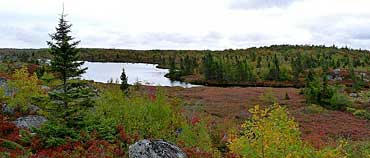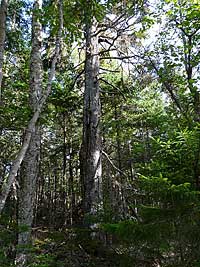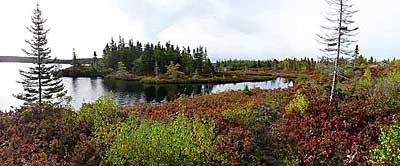The Bluff Wilderness Hiking Trail
The The Bluff Wilderness Hiking Trail is located on Crown Land south of Highway 103 where it crosses the Chebucto Peninsula just west of Halifax, Nova Scotia. It begins inside the Woodens River watershed and climbs onto the high ground ("The Bluff" ) between the Woodens River watershed and the Nine Mile River watershed to the east.

The trailhead is located on the Beechville-Lakeside-Timberlea (BLT) trail at a point midway between the Hwy 103 overpass just south of Exit 4 and the northern tip of Cranberry Lake. A parking lot has been constructed specifically for visitors to The Bluff Trail. See Getting There.
|
There are canoe-access points at the south ends of each of Cranberry Lake, Frederick Lake, and Hubley Big Lake (see map, above).
Safety & Trail Etiquette
The signs at the trailhead emphasize that this trail is for experienced hikers; they warn hikers of some of the potential dangers of wilderness hiking.
Carry
|  |
Deer hunting season runs from the last Friday in October to the first Saturday in December inclusively. Hunting is not permitted on Sundays. Hunter orange is recommended in this period. Please use The Bluff Trail with added caution during this period.

Natural Assets
 The trail passes through several landscape types, including patches of deciduous woodland dominated by red maple or oak as well as large black spruce stands, mixed red spruce/deciduous forest, fens, and open granite barrens. The barrens support extensive populations of broom crowberry, a coastal plain species threatened elsewhere, and the rare mountain sandwort. Over 100 species of lichens have been documented on the trail.
The trail passes through several landscape types, including patches of deciduous woodland dominated by red maple or oak as well as large black spruce stands, mixed red spruce/deciduous forest, fens, and open granite barrens. The barrens support extensive populations of broom crowberry, a coastal plain species threatened elsewhere, and the rare mountain sandwort. Over 100 species of lichens have been documented on the trail. The trail moves generally along high ground, affording frequent stunningly beautiful vistas of the surrounding wilderness and lakes. At one point it runs through a stand of large old growth red spruce between Pot and Cranberry Lakes. The third loop takes hikers over the Bluff plateau, which is one of the highest points near Halifax; a large stand of jack pine occurs on the branch common to loops 3 and 4.
|
The purpose of the trail is to allow the Woodens River community and the public generally to become aware of the extraordinary natural assets of this area, on the principle that awareness is the first step in protection.
Much of this land is barrens and unsuitable for harvesting wood and, at least until recently, difficult to develop into residential areas. As a result it has been left wild. It is wild not only in the sense of being undeveloped but in the sense of not being directly controlled by human needs and interests. Hunters visit the areas in hunting season, but for the most part these areas have remained undisturbed by frequent human travel. The bush in these areas is often extremely dense. Hiking in these areas is difficult without trails.

For them, walking in the solitude of ancient rocks and fens will bring wonder and joy. They may hesitate to let others know about it, afraid it will be destroyed and that they will have betrayed the wild lives that own this place. They may be afraid too that if they don't, the consequences will be the same.
We believe that once people have experienced this wildness, most will understand its importance to their lives and the lives of their children and will not let it be destroyed. Trail Dedication
A sign dedicating The Bluff Wilderness Hiking Trail to wilderness preservation was placed at the junction for the Pot Lake Loop, the first of four successive loops making up The Bluff Trail, in the summer of 2010. It's a peaceful, contemplative setting. Reads the sign:

On behalf of all the wild things that make this land their home and with reverence for the First People who preserved this land before us, we dedicate The Bluff Wilderness Hiking Trail to wilderness preservation. We do this in trust that we can learn its deep beauty, in trust that we can understand and delight in the wildness in ourselves that we share with the rocks, earth, water, and teeming life and spirits that surround us, and in trust that we will work together to protect this sacred heritage.That statement was written by Richmond Campbell on completion of the trail in 2005.



